Gokyo Lakes Trek - Highlights, Overview, Itinerary, Best Time To Go, Difficulty, PeRmits & Packing list
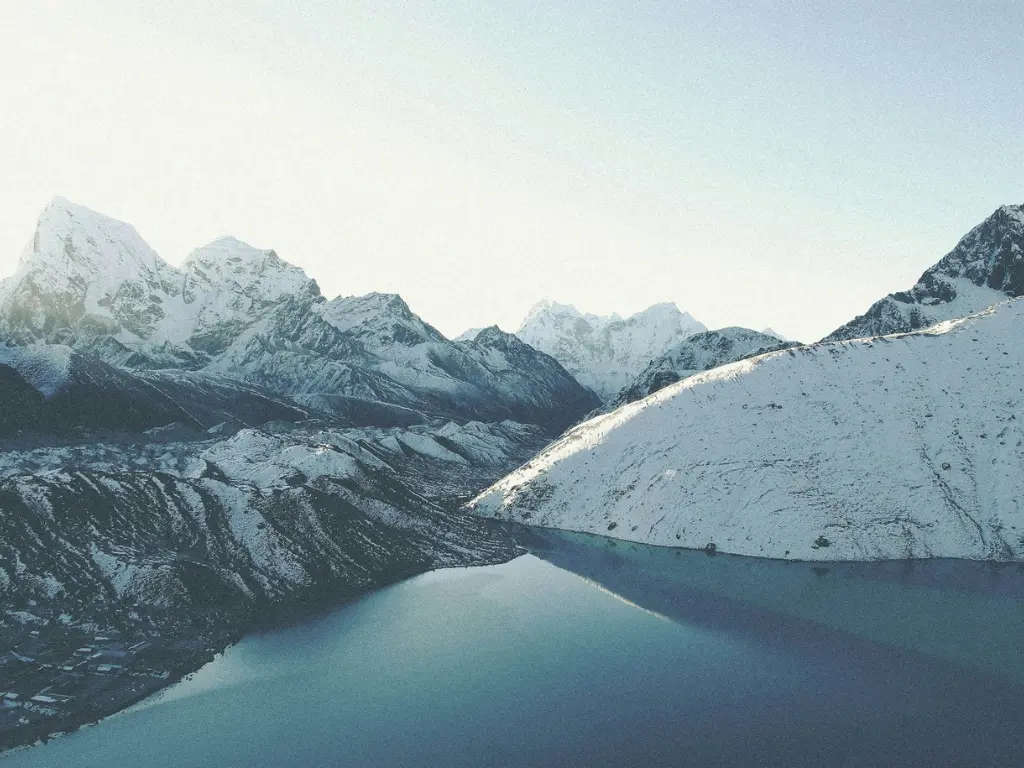
The Gokyo Lakes Trek commonly known as Gokyo Valley Trek or Gokyo Ri Trek is one of the popular destinations for trekking in Nepal. The trek takes you to the picturesque Gokyo Valley towards the west of the Khumbu region which is a part of Sagarmatha National Park. The Gokyo Valley consists of tiny village settlements in the Himalayas where most houses are tea houses that provide trekkers with essential services. The valley is situated at an elevation of 4,750 m / 15,584 ft making it one of the highest settlements in Nepal.
The Gokyo trek is a popular trekking route and one of the best treks in the Everest region.
Gokyo Ri, the highest point on the Gokyo Lakes trek is a famous landmark for witnessing four 8,000-metre peaks: Mount Everest, Lhotse, Makalu, and Cho Oyu.
The Gokyo Lakes are located in Khumjung, a village of Solukhumbu District in the Sagarmatha Zone. Gokyo Cho, also called Dudh Pokhari, is the main lake in the Gokyo Valley with an area of 42.9 ha (106 acres).
The Gokyo lakes are considered sacred by both Hindu and Buddhist devotees. The devotees come to take a holy bath in the lakes during the Janai Purnima festival, which usually occurs in August. The site is worshipped as the residing place of Nag Devata (Snake God); a temple of the Hindu deities Vishnu and Shiva is situated at the western corner of the lake.
Gokyo Lakes also called Dudh Pokhari comprises six main lakes (Gokyo Cho, Thonak Cho, Gyazumpa Cho, Tanjung Cho, Phanok Cho, and Ngojumba Cho) are the world’s highest freshwater lake of which Thonak Cho is the largest. Gokyo and its associated wetlands covering an area of 7,770 ha (30.0 sq mi) have been designated a Ramsar Site.
The trek's highlights include the stunning Gokyo Lakes, the expansive Ngozumpa Glacier, and the panoramic view from Gokyo Ri, where you'll witness four of the world's tallest peaks, including Everest. Along the way, you'll also experience the unique culture of the Khumbu region, with stops in traditional Sherpa villages.
In this section, I provide a broad view of what you can expect from the Gokyo Lakes Trek, from the natural beauty of the Himalayas to the immersive cultural encounters. You’ll get an understanding of the trek's route, elevation, and the overall experience awaiting you. The 10-day Gokyo Lake Trek itinerary starts from Gokyo and ends at Gokyo. You'll know exactly what to expect, including trekking distances, key landmarks, and resting points along the way.
The best time for the Gokyo Lakes Trek is the spring (March-May) and autumn (September-November) seasons. These seasons offer clear skies, moderate temperatures, and the most stable weather conditions, ensuring the best views and a comfortable trek. This trek is rated as moderately difficult due to the high altitudes and the length of daily hikes. While it doesn't require technical climbing skills, good physical fitness, and proper acclimatization are essential to handle challenging terrain and elevation.
You’ll need two essential permits for the Gokyo Valley trek: the Sagarmatha National Park Entry Permit and the Khumbu Pasang Lhamu Rural Municipality Permit. These permits are required to access the national park and support local conservation efforts.
Preparing for the Gokyo Lakes Trek requires careful packing. Essential items include warm clothing, sturdy trekking boots, a good-quality sleeping bag, and gear for high-altitude conditions. Don’t forget essentials like sunscreen, a first aid kit, and trekking poles to make your journey more comfortable and safe.
What are the Highlights of the Gokyo Valley Trek?
- Experience a thrilling and scenic flight to the World’s most dangerous Lukla airport.
- Stunning views of the Gokyo Lakes, a series of six turquoise glacial lakes surrounded by the majestic Himalayan mountains.
- Climbing Gokyo Ri (5,357 m), a viewpoint that offers breathtaking panoramic vistas of the Everest massif, including peaks like Everest, Lhotse, Makalu, and Cho Oyu.
- Exploring the Sherpa culture and visiting charming villages like Namche Bazaar, Dole, and Machhermo to learn about their traditions and way of life.
- Witnessing the diverse flora and fauna of the Sagarmatha National Park, including musk deer, Himalayan Thar, snow leopards, pheasants, and snow cocks.
- Experiencing the warm hospitality of the local Sherpa people and staying in their traditional lodges along the trek.
Gokyo Lakes Trek Route Overview on the Sagarmatha National Park
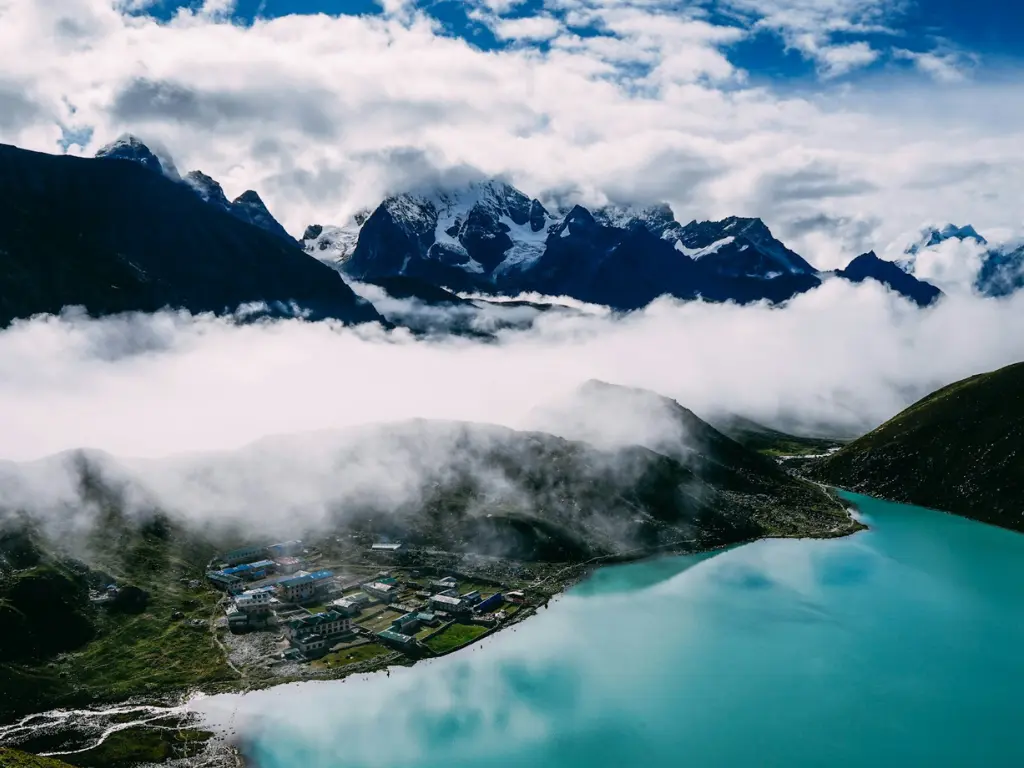
Gokyo Lakes Trek in the Everest region involves walking through the Sherpa homeland and the bustling market of Namche Bazaar, the ethnic villages of Khumjung, Dole, Phortse Thanga, and Machhermo. You will walk through several beautiful rhododendron forests, and suspension bridges decorated with Buddhist flags. Breathtaking views of Gokyo lakes are the major highlights of the Gokyo lake trekking.
The trek itself ends at Gokyo Ri summit, and trekkers typically turn around after climbing the summit and retrace their steps back to the trailhead. Gokyo Ri or Gokyo Peak is situated at an altitude of 5,357 m / 17,575 ft in the Khumbu region of the Nepal Himalayas. It is located on the west side of the Ngozumpa glacier, which is the largest glacier in Nepal. You can witness the Ngozumpa Glacier from the slopes of Gokyo Ri.
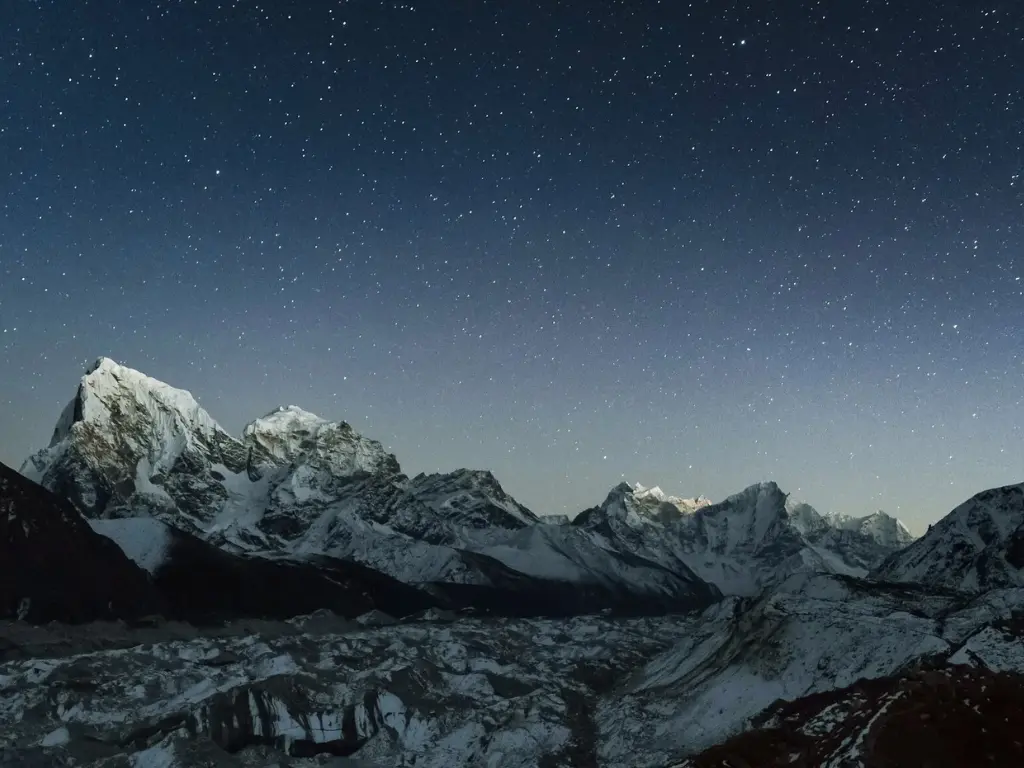
The Gokyo Lakes Trek begins with a scenic and adventurous mountain flight to Lukla Airport - also known as Tenzing Hillary Airport. Gokyo Lakes Trek is the second most popular trek route after the Everest Base Camp in the Khumbu region of Nepal. The heavily crowded Everest Base Camp trail can be avoided by taking a less traveled route through a remote trail to the Gokyo Valley.
Once you reach Lukla, you will take a short 3-hour hike to Phakding (2,650m). There is no rush on the first day of your trek. The following day, you will leave Phakding for Namche Bazaar(3,440m) - the gateway to Everest and the largest town in the Khumbu region of Nepal. On the way to Namche, after entering the Sagarmatha National Park, you can get the first glimpses of Mt. Everest if the weather conditions are good.
After acclimatizing for a day at Namche, you will continue your trek to Dole while enjoying the views of Mount Amadablam (6,812 m) and Khumbila (5,761 m).
The trek from Dole to Macchermo will be very scenic as you will trek on a route filled with vibrant prayer flags. In the right season, you can see yaks grazing on meadows on your way.
On the sixth day of your trek, you will reach Gokyo village, your final destination of the trek. You will be amazed by the marvelous Gokyo Valley adorned by mountains, glaciers, and oligotrophic lakes. Since it will not be enough to appreciate all the views of Gokyo Valley, the next day you will ascend to the challenging yet rewarding Gokyo Ri summit or a viewpoint situated at an altitude of (5,350m/17,562ft).
You will enjoy close-up views of four of the highest peaks - Mount Everest (8,848m/29,028ft), Cho Oyu (8,201m), Lhotse (8,516m), and Mount Makalu (8,463m). Along with the rustic beauty, these lakes have religious significance as well.
After witnessing the beauty of Gokyo Valley and climbing the Gokyo Ri, you will descend to Machhermo following the same trek route.
On your eighth day, you will return to Namche Bazaar from Machhermo. You will find the crowds and the number of trekkers preparing for their treks and expeditions at Namche Bazaar after spending your time in tranquility in the remote Himalayan villages.
On your ninth day, you will return from Namche Bazaar through Phakding to Lukla. This will be the last day on the trek route of Everest Region. You will spend your last night in the trek region at Lukla.
The following morning, you will fly from Lukla to Kathmandu marking the end of your journey to beautiful Gokyo lakes in the Khumbu Region of Nepal.
How is the Day-to-Day Itinerary of Gokyo Lakes Trek?
Day 1: Kathmandu to Lukla By Flight. Trek to Phakding.
Flight time: 32 minutes
Trek Time: 3 to 4 hours
Accommodation: Tea House
Trek Distance: 6.2 km/3.8 miles
It is an early morning flight to Lukla Airport, one of the most thrilling airports in the world. Lukla is the starting point of all Everest region treks.
The cold and fresh air hits you on arrival at Lukla and the views will take your breath away. Once you land at Lukla, you will witness the beautiful sight of Mt. Khumbila, a sacred mountain that has never been climbed. Your trek to Gokyo Lakes officially starts from Lukla.
Phakding is approximately a 3-hour hike from Lukla. Crossing a suspension bridge, passing a monastery, and seeing perhaps your first mani (prayer) wall are some of the highlights of the day.
You will stay in Phakding for the day.
Day 2: Trek from Phakding to Namche Bazaar
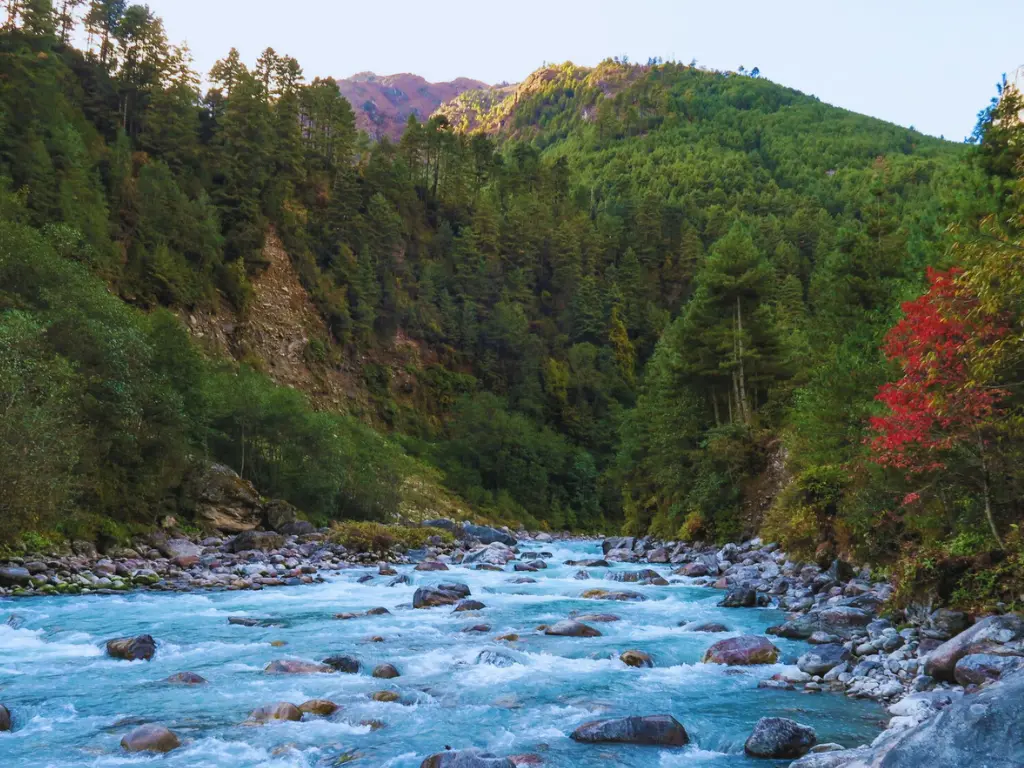
Trek Time: 5 to 6 hours
Accommodation: Tea House
Trek Distance: 7.4 km / 4.6 miles
After breakfast, you set off for a day to reach the bustling market town of Namche Bazaar. You will trek alongside the Dudh Koshi River with lush green landscapes, pass abundant villages, and monasteries, and even cross the suspension bridges.
One of the suspension bridges you will cross is the epic Hillary Suspension Bridge, named after the legendary mountaineer Sir Edmund Hillary.
At Monjo, your trekking permits will be checked and then you enter the Sagarmatha National Park. Sagarmath National Park is the country's first national park that was listed as a Natural World Heritage Site.
You will witness the breathtaking views of Kusum Peak, Kwangde Peak, Lhotse, Kangaru Peak, Tawache, and the highest mountain Everest. Once you reach Namche you will see dozens of trekkers and climbing expeditions gathered before heading out on their respective adventures.
You will stay overnight at Namche Bazaar.
Day 3: Acclimatization Day in Namche Bazaar.
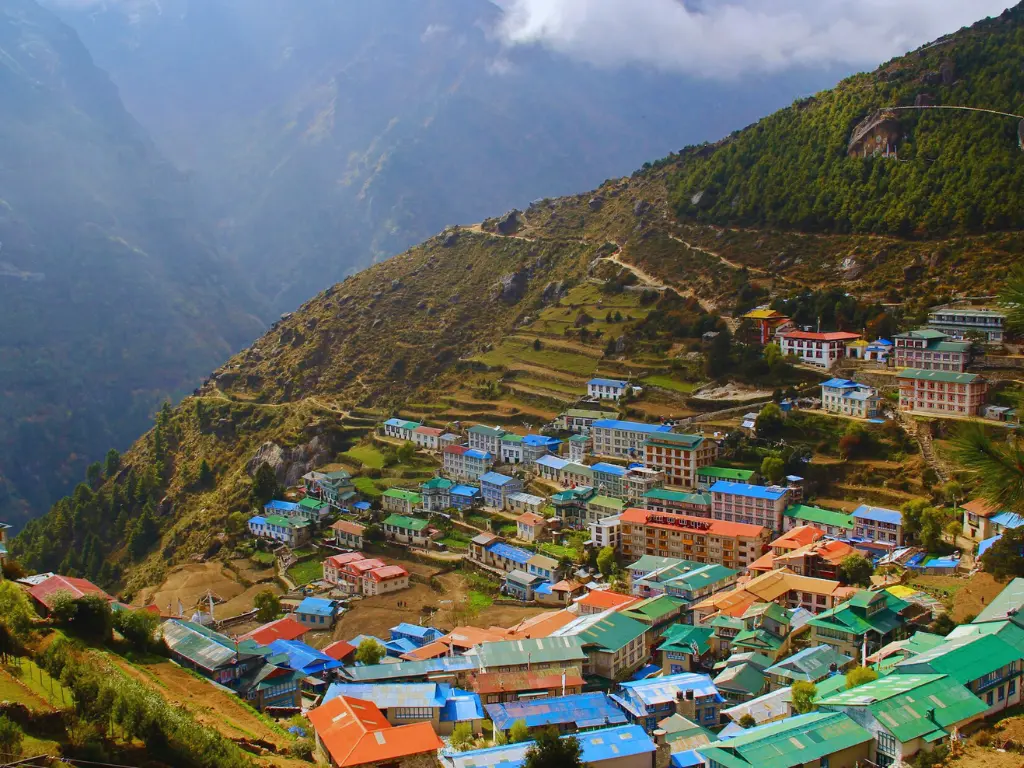
Trek time: 5 to 6 hours
Accommodation: Tea House
Trek Distance: 7.4 km / 4.6 miles
Today is the acclimatization day at Namche Bazaar. There are several walks around Namche Bazaar for you to acclimatize your body.
You can start your acclimatization day with a 2 hour morning hike to Everest View Hotel for a cup of coffee or breakfast. From the hotel, You can witness Mount Everest, Lhotse, Nuptse, Ama Dablam, Khangtega, Thamserku, Taboche, and Khumbila. After spending quality time at the Everest View Hotel, you will head to Khumjung Village.
In Khumjung Village, you will be visiting the Khumjung monastery where the Yeti scalp is kept in this monastery. You will then ascend to Syangboche and witness the mind-blowing views of Thamserku, Khumbila, and Kongde peaks.
You will then hike back to Namche Bazaar and spend your night.
Day 4: Namche Bazaar to Dole
Trek time: 6 hours
Accommodation: Tea House
Trek Distance: 7.4 km/4.6 miles
After acclimatization day at Namche Bazaar, you are ready to head up to Dole. The route to Dole is very scenic as you leave the classic EBC trek route.
You will walk through the rhododendron forest and reach Kyanjuma and then Sansa village. The trail is uneven and lies just above the Dudh Koshi River’s gorge.
Further hike will take you to the Mong La Pass from where you can enjoy the sight of Mt. Ama Dablam, Mt. Thamserku, Mt. Tawoche, and Mt. Khumbila. From the pass, you will gradually walk downhill to the Dudh Koshi River. Then after a short uphill climb via Rhododendron forests, you will reach Phortse.
After hiking for a few hours through green lush forests you will reach Dole. On arrival, you can enjoy the mesmerizing sunset views over the mighty peaks.
Day 5: Dole to Machhermo
Trek time: 5 to 6 hours
Accommodation: Tea House
Trek Distance: 7 km/4.3 miles
Today, you will begin your trek with gentle climbing. You will come across several shrines and lots of prayer flags to Lapharma. From here, you will enjoy a beautiful view of Mt. Cho Oyu, the sixth-highest mountain in the world. You can also enjoy some of the world’s tallest peaks including Mt. Kantega and Mt. Thamserku.
While enjoying the picturesque landscape and walking for a few hours you enter Luza Valley. And in a short distance, you will reach the small village of Machhermo.
You will stay overnight at Machhermo.
Day 6: Machhermo to Gokyo Valley
Trek Time: 4 hours
Accommodation: Tea House
Trek Distance: 8 km / 5 miles
Today’s trek will lead you to pristine Gokyo Valley, the final destination of the trek. After walking for an hour from Machhermo you will reach Phanga. Phanga is dedicated to the people who lost their lives in landslides.
The trail descends to the Dudh Koshi River. It is a steep climb to the Ngozumpa Glacier and the first Gokyo Lake.
As you continue to the north, the second lake appears. Further on, the 3rd lake arrives with some teahouses. All these lakes come under the name of Gokyo Lake.
Day 7: Early Morning Hike to Gokyo Ri (5, 357 m / 17,575 ft). Trek Back to Machhermo.

Trek Time: 4 hours
Accommodation: Tea House
Trek Distance: 6.8 km / 4.2 miles
Today, your day starts with an uphill climb to Gokyo Ri, one of the main attractions of the trek. It is better to reach the top of Gokyo Ri Peak to catch the stunning sunrise over the mountains.
The distance is not too long but the challenging uphill climb makes this hike difficult. This challenging ascent is worth the view. You will witness the sight of the mighty Himalayas, beautiful Gokyo lakes, and Ngozumpa glaciers at once from the top of the Gokyo Ri viewpoint.
You will get views of four of the highest peaks- Mt Everest (8,848m), Cho Oyu (8,210m), Lhotse (8,516m), and Makalu (8,463m).
After spending a marvelous time at Gokyo village you will trek back to Machhermo village.
You will stay overnight in Machhermo village.
Day 8: Machhermo to Namche Bazaar
Trek Time: 8 hours
Accommodation: Tea House
Trek Distance: 21 km/13 miles
After an early breakfast at Machhermo, you will head on towards Namche Bazaar. You will walk through the dense forests home to several musk deer and mountain goats
Namche feels quite lively and busy and you spend your final night of the trek here.
Day 9: Namche Bazaar to Lukla
Trek Time: 8 hours
Accommodation: Tea House
Trek Distance: 13.6 km / 8.4 miles
Today, you will follow the Dudh Koshi River, and cross the suspension bridges once again to reach Lukla. You will stay overnight at Lukla and wait for your flight back to Kathmandu early the next morning.
Day 10: Lukla to Kathmandu By Flight
After early morning breakfast, you will head towards the Lukla airport. A short flight brings us back to the country’s capital, Kathmandu.
Gokyo Lakes Trek Distance From Lukla
The total distance of the Gokyo Lakes Trek from Lukla as a round trip is 87 km / 54 miles.
Let us break down each trekking point distance in a table format.
| Days | Starting & Ending Points | KM | Miles |
| 01 | Lukla - Phakding | 6.2 | 3.8 |
| 02 | Phakding - Namche Bazaar | 7.4 | 4.6 |
| 03 | Acclimatization Day at Namche Bazaar | 7.4 | 4.6 |
| 04 | Namche Bazaar - Dole | 7.4 | 4.6 |
| 05 | Dole - Machhermo | 7 | 4.3 |
| 06 | Machhermo - Gokyo - Gokyo Ri | 10 | 6.2 |
| 07 | Gokyo - Machhermo | 6.8 | 4.2 |
| 08 | Machhermo - Namche Bazaar | 21 | 13 |
| 09 | Namche Bazaar - Lukla | 13.6 | 8.4 |
The trekking distance depends upon the itineraries you choose.
When is the Best Time and Season For the Gokyo Trek?
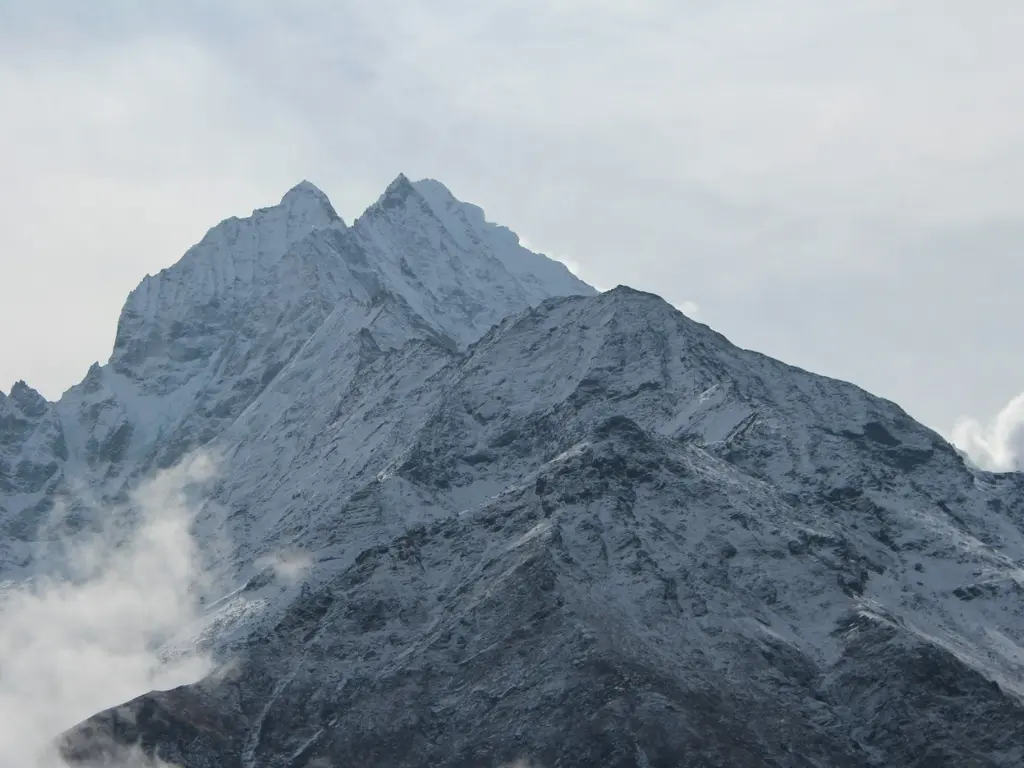
Choosing the right time for your Gokyo Lakes Trek is crucial to ensure an enjoyable and safe journey. People trek to Gokyo Ri throughout the year, but there are some favorable seasons.
Spring and Autumn seasons are considered the best times for the trek. The days are clear, no rainfall, and the temperature is just right, making the treks very enjoyable.
The summer season in Nepal brings monsoon rain, making the trails wet and slippery. Some trekkers, who love waterfalls and rain trek to Gokyo Ri during summer.
Similarly, the trek regions in the winter season receive heavy snowfall in winter, but some trekkers love challenging treks in winter.
Spring Season (March to May)
Spring season, which spans from March to May, is arguably the most ideal time to trek to Gokyo Valley. During these months, the weather is relatively stable, and temperatures are moderate.
As the snow melts, the trails become more accessible, making it easier for trekkers of all experience levels. One of the highlights of spring is the blossoming rhododendrons. The hills come alive with vibrant blooms, adding vibrant colors to the landscape.
Additionally, the skies are generally clear, offering uninterrupted views of Mount Everest, Mount Lhotse, and other towering peaks. Spring is also an excellent time for spotting wildlife, such as Himalayan Thar and the elusive snow leopard.
Autumn Season (September to November)
Autumn, from September to November, is another fantastic season for trekking to the Gokyo Lakes. After the monsoon rains, the air is crisp and clean, and the landscape is lush and green.
This period is considered the best for high visibility, providing trekkers with some of the most spectacular mountain views. The weather during autumn is stable, with mild days and cool nights, perfect for trekking.
This season coincides with major Nepali festivals like Dashain and Tihar, offering a unique cultural experience. While autumn is popular, the trails are less crowded than in spring, providing a more serene trekking experience.
Winter Season (December to February)
Winter, from December to February, offers a unique and rewarding experience. The trails are quieter, and the snow-covered landscape is simply magical.
The snow transforms the region into a winter wonderland, offering stunning photography opportunities. With fewer trekkers on the trails, you can enjoy the serenity and solitude of the mountains.
Trekking in winter is more challenging, providing a greater sense of adventure and accomplishment.
Summer Season (June - August)
The summer season from June to August brings monsoon rain and may not be the best time for the Gokyo Lakes trek, but it has its own set of advantages and challenges.
The monsoon rains bring lush greenery, but they also make the trails slippery and leech-infested. The monsoon rains turn the landscape into a verdant paradise, with blooming flowers and flowing rivers. Fewer trekkers mean more peaceful trails and more opportunities for personal reflection.
However, be prepared for rain, mud, and potential landslides, cloudy days making the trek more difficult and less predictable.
How Difficult is the Gokyo Lake Trek?
The Gokyo Lakes trek is moderately difficult and requires a good level of physical fitness. Trekkers should be prepared for long days of walking, often ranging from 5 to 8 hours per day. The trail involves a mix of steep ascents, descents, and relatively flat sections.
With the right physical preparation, proper acclimatization, and mental resilience, most trekkers with a reasonable level of fitness can complete this trek.
What are the Permits Required For Gokyo Valley Trek?
You will require 2 permits, a Khumbu Pasang Lhamu Rural Municipality Entrance Permit and a Sagarmatha National Park Entry Permit for Gokyo Valley Trekking. Let us dive deep into each trekking permits
1.) Khumbu Pasang Lhamu Rural Municipality Entrance Permit
You can get Khumbu Pasang Lhamu Rural Municipality Entrance Permit in Lukla. Please remember you cannot get this permit in Kathmandu.
The permit costs NPR 2000 per person for the first four weeks and NPR 2500 per person for stays longer than four weeks. No VAT applies to the permit fees.
The cost of the Khumbu Pasang Lhamu Rural Municipality permit is the same for everyone outside of Nepal, including SAARC nationals, foreign nationals, and NRNs (Non-Resident Nepalese).
2.) Sagarmatha National Park Entry Permit
You can obtain a Sagarmatha National Park Entry Permit either in Kathmandu at the Nepal Tourism Board Office or in Monjo at the Park Entrance Gate.
Sagarmatha National Park Entry Permit costs around NRs. 3000 for foreign trekkers. [Outside of Nepal and SAARC countries].
If you are from SAARC Countries (Afghanistan, Bangladesh, Bhutan, India, Maldives, Pakistan, and Sri Lanka), permit costs around NPR.1500 per person.
Similarly, the cost of a Permit for Nepalese trekkers is only NPR 100 per person. Trekkers under 10 years old can obtain this permit without any charges or fees as a child discount.
What are the Packing Lists for the Gokyo Lakes Trek With Gokyo Ri?
Headwears
- Sun Hat / Brimmed Hat
- Winter Hat
- Microfleece buff / Neck Gaiter
Bodywear
- Thermal Base Layer Set / Inner Layer Set
- Hiking Shorts
- Hiking T-Shirt
- Hiking Pants
- Down Jacket
- Waterproof Jacket with Hood
Handwear
- Thin Lightweight Gloves
- Heavyweight Winter Gloves
Footwear For Trekking
- Trekking Boots with Spare Laces
- Sandals or Flipflops
- Hiking Socks
- Inner Socks
Gear and Additional Accessories
- Rucksack with Rain Cover (50L – 60L )
- Raincoat.
- Trekking Poles.
- Sleeping bag (if you are trekking in winter seasons).
- Reusable Water Bottles.
- Thermal Flask to Store Warm Water.
- Power Bank.
- Local SIM card.
- Cash in Nepali Currency.
- Camera and Binoculars (Optional).
- Duct Tape (Optional).
- Head Torch.
- UV protection sunglasses.
Extras and Medical Supplies
- Sunscreen.
- Sanitizer.
- Deodrants.
- Moisturizer creams.
- Lip Balms with SPF.
- Water purification tablets.
- Games and books (Optional).
- Bandages.
- Antiseptic Cream.
- Pain Relievers.
- Blister Plasters
- Painkillers.
- Anti-Diarrhoea Tablets.
- Tablets for Cold and Gastric.
- Diamox for altitude sickness (only after consultation with a medical professional).
- Anti-inflammatories.
Toiletries
- Quick-drying Towel.
- Toothbrush and Toothpaste.
- Biodegradable Soap.
- Nail Clipper (optional).
- Toilet Paper.
- Wet Wipes.
How are Accommodations and Food on the Gokyo Trek?
Accommodations
Teahouses are the main types of accommodation on the Gokyo Trek. These are small lodges that offer basic rooms, meals, and services to trekkers. They are usually run by local Sherpa families who live in the region.
Teahouses vary in size, quality, and price depending on the location and the season.
The rooms are usually twin-sharing with small wooden beds, mattresses, pillows, and blankets. Some rooms may have attached bathrooms with western toilets and hot showers depending upon the location, while others may have shared bathrooms outside.
All the teahouses have a communal dining hall where trekkers can gather and interact with each other and the meals are served for all the trekkers in a communal dining hall.
Food Choices
The Gokyo Lakes trek with Gokyo Ri takes place in high elevations. So, you will require plenty of hygienic nutrient-rich food. You will get enough nutritious food, but as you climb up, your choices get limited.
The food menu includes mostly local, Asian, and Western cuisine, but as you go up, the menu gets shorter.
Some of the popular menu items are-
Morning breakfasts - Oatmeal, Corn Flakes, French Toast with Jam, Butter, Cheese, and Honey Tibetan Bread or Chapati, Hashed Brown Eggs, eggs, Porridge, Pancakes, Muesli Breads, Fruits and Vegetables, Hot Drinks - varieties of Teas, Coffees, Hot Chocolates, etc.
Lunches Options - Dhal, Bhat & Tarkari, Tibetan Bread, Various Soup Items, Spaghetti, Thukpa, Pasta, Vegetable Curry, Potatoes, Sherpa Stew, Steaks, Sandwiches, Momo (Dumplings), Macaroni Dishes, Salad, Pizza, Snacks, Dessert Items (Rice Pudding, Apple pie), etc.
Dinner Options- Dal (lentils), Bhat (Rice) & Tarkari (Curry), Tibetan Bread, Various Soup Items, Sherpa Stew, Steaks, Vegetables, Salads, Sandwiches, Momo (dumplings), Macaroni Dishes, Spaghetti, Thukpa, Pasta, Vegetable Curry, Potato Items, Pizza, Snacks, Papad, Prawn, Korean Ramen, Rice Pudding, Apple Pie etc
At high altitudes, have enough liquids like green tea, lemon tea, hot lemon, ginger tea, garlic soup(must), etc - along with fresh vegetables for health benefits.
Though plenty of non-veg items are available they are not recommended because the meat in the trek regions may not be hygienic.
How is the Access to Electricity and Water in the Gokyo Lakes Trek?
Electricity access on the trek varies from village to village. In the areas like Lukla and Namche Bazaar, electricity is relatively reliable.
However, as you ascend above Namche Bazaar, electricity is provided through solar panels and electricity availability becomes less consistent. These sources can be unreliable due to weather conditions and limited capacity.
You need to pay an extra cost to charge your electronic devices like phones, camera batteries, etc. However, the service may be limited depending on the weather conditions.
Staying hydrated is vital to avoid altitude sickness. Water is easily available in the teahouses and en-route shops. Using a water purifier is recommended and not drinking directly from any water source you find on the trek route.
Teahouses charge a certain amount for hot water if you want to refill your thermal flask depending upon the location.
FAQS
How long is the Gokyo Lake Trek?
The Gokyo Lake Trek is 10 Days Long. However, the duration depends upon the itinerary you choose.
How hard is the Gokyo Lake trek?
The Gokyo Lakes trek is considered a moderately difficult trek. The trek demands an average trekking duration of 5 to 8 hours exploring and climbing through the steep section, both uphill and downhill.
Can I Combine Gokyo Lakes with Everest Base Camp?
Yes, you can combine Gokyo Lakes with Everest Base Camp. You can follow the classic EBC trek route and cross the Cho La Pass to reach Gokyo Lakes and Gokyo Ri.
It will take you 16 Days to complete the trek if you combine Gokyo lakes with Everest Base Camp.
Do I need to acclimatize en route to Gokyo Valley?
Yes, you need to acclimatize en route to Gokyo Valley. Your acclimatization day will be on Day 3 at the Namche Bazaar where you will hike up to the Everest Hotel and explore Khumjung Village.
How fit should I be for the Gokyo Lake Trek?
You should be physically fit with a good level of stamina and endurance to complete the trek.
Do I Need a previous trekking experience for the trek?
No, you do not need to have a previous trekking experience for the trek. As the trek is physically challenging, you must have good physical fitness with strength and stamina to hike around 5-8 hours per day.
